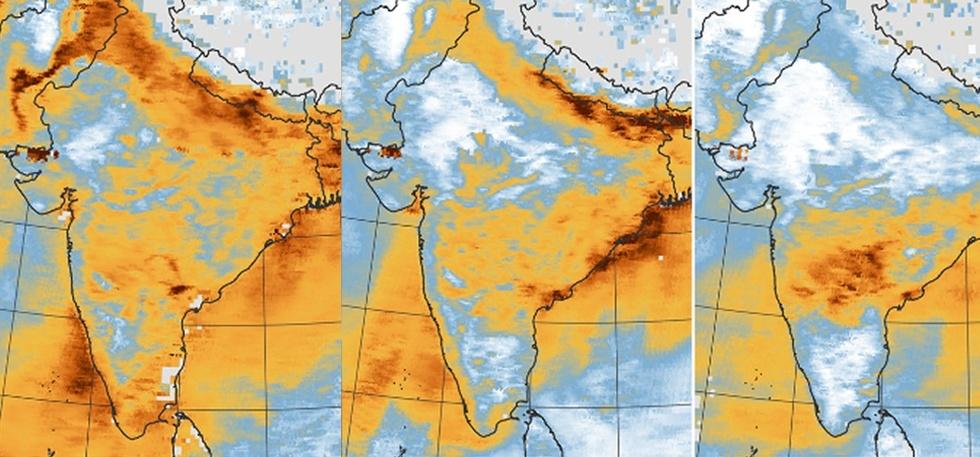Satellite Images Suggest That North India’s Aerosol Levels To Be At A 20-Year Low
Harin - Apr 23, 2020

Satellite images from NASA suggest that North India’s aerosol levels have plummeted to a 20-year low thanks to the nationwide lockdown.
- This Man's Super-Antibody Can Be Diluted 10,000 Times But Still Works Against COVID-19
- These Indian Cities Are Under Lockdown Again In 2021
- India To Review Covishield Vaccine After Report Of Blood Clots Following Vaccination
Thanks to the nationwide lockdown, the air pollution levels of India has been decreased. Now, satellite images from NASA suggest that North India’s aerosol levels have plummeted to a 20-year low.
A report points out that every year, many Indian cities’ alarming levels of air pollution are the result of aerosols from man-made sources. Aerosols are tiny liquid and solid particles that are trapped in the air. These particles reduce visibility as well as damaging the human heart and lungs.
Aerosols have many different types. There are aerosols that are from natural sources like forest fires, volcanic eruptions, and dust storms. Others are from human activities like the burning of croplands and fossil fuels. Most of the smaller particles are human-made, having a greater effect on human health.

Pawan Gupta, a scientist at Universities Space Research Association, Marshal Space Flight Center, NASA, stated that due to the lockdown, it was understandable for the changes in many places’ atmospheric composition. However, the aerosol values in the Indo-Gangetic Plain have never reached this low before.
The AOD (aerosol optical depth) measurements over the country during the same period (from March 31 to April 5) from 2016 to 2020 are compared.
Aerosol optical depth measures the absorption and reflection of light by airborne particles as it moves through the atmosphere.

The data was collected by the Moderate Resolution Imaging Spectroradiometer on the Terra satellite of NASA.
Normally, in early spring, the Ganges Valley in Northern India sees a huge amount of human-made aerosols. Vehicles, coal-fired power plants, and industries all contribute to the production of sulfates and nitrates as well as other carbon-rich particles.
The report stated that due to the 2020 lockdown, all human-made emission sources in India’s urban and rural areas have been reduced significantly.
As seasonal dust storms will begin in the next few weeks in India, there might be a slight increase in the aerosol levels. In the first few days following the implementation of the nationwide lockdown, scientists believed that it was the combination of the lockdown and rain that caused the low aerosol levels. However, after the rain, they discovered that the levels didn’t increase.

In Southern India, they couldn’t observe the same pattern, but it could be because of the weather or wind patterns.
At the moment, the low aerosol levels mean fresher air for people living in Northern India.
>>> Thanks To Lockdown, Indian Cities Are Temporary Out Of The World’s Top 20 Polluted Cities
Featured Stories

Features - Jul 01, 2025
What Are The Fastest Passenger Vehicles Ever Created?

Features - Jun 25, 2025
Japan Hydrogen Breakthrough: Scientists Crack the Clean Energy Code with...

ICT News - Jun 25, 2025
AI Intimidation Tactics: CEOs Turn Flawed Technology Into Employee Fear Machine

Review - Jun 25, 2025
Windows 11 Problems: Is Microsoft's "Best" OS Actually Getting Worse?

Features - Jun 22, 2025
Telegram Founder Pavel Durov Plans to Split $14 Billion Fortune Among 106 Children

ICT News - Jun 22, 2025
Neuralink Telepathy Chip Enables Quadriplegic Rob Greiner to Control Games with...

Features - Jun 21, 2025
This Over $100 Bottle Has Nothing But Fresh Air Inside

Features - Jun 18, 2025
Best Mobile VPN Apps for Gaming 2025: Complete Guide

Features - Jun 18, 2025
A Math Formula Tells Us How Long Everything Will Live

Features - Jun 16, 2025
Comments
Sort by Newest | Popular